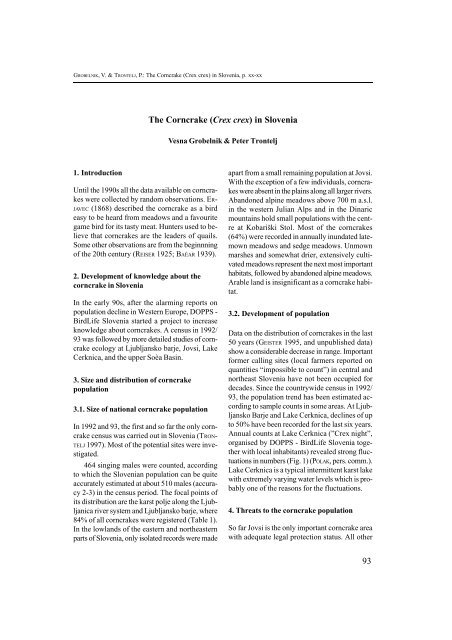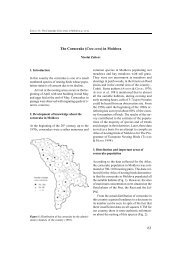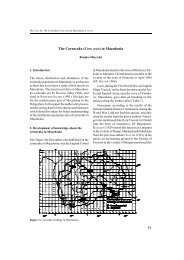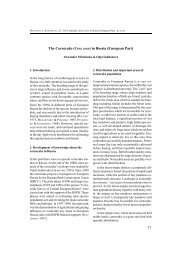93 The Corncrake (Crex crex) in Slovenia - Corncrake.net
93 The Corncrake (Crex crex) in Slovenia - Corncrake.net
93 The Corncrake (Crex crex) in Slovenia - Corncrake.net
You also want an ePaper? Increase the reach of your titles
YUMPU automatically turns print PDFs into web optimized ePapers that Google loves.
GROBELNIK, V. & TRONTELJ, P.: <strong>The</strong> <strong>Corncrake</strong> (<strong>Crex</strong> <strong>crex</strong>) <strong>in</strong> <strong>Slovenia</strong>, p. xx-xx<br />
1. Introduction<br />
Until the 1990s all the data available on corncrakes<br />
were collected by random observations. ER-<br />
JAVEC (1868) described the corncrake as a bird<br />
easy to be heard from meadows and a favourite<br />
game bird for its tasty meat. Hunters used to believe<br />
that corncrakes are the leaders of quails.<br />
Some other observations are from the beg<strong>in</strong>nn<strong>in</strong>g<br />
of the 20th century (REISER 1925; BAÈAR 1<strong>93</strong>9).<br />
2. Development of knowledge about the<br />
corncrake <strong>in</strong> <strong>Slovenia</strong><br />
In the early 90s, after the alarm<strong>in</strong>g reports on<br />
population decl<strong>in</strong>e <strong>in</strong> Western Europe, DOPPS -<br />
BirdLife <strong>Slovenia</strong> started a project to <strong>in</strong>crease<br />
knowledge about corncrakes. A census <strong>in</strong> 1992/<br />
<strong>93</strong> was followed by more detailed studies of corncrake<br />
ecology at Ljubljansko barje, Jovsi, Lake<br />
Cerknica, and the upper Soèa Bas<strong>in</strong>.<br />
3. Size and distribution of corncrake<br />
population<br />
3.1. Size of national corncrake population<br />
In 1992 and <strong>93</strong>, the first and so far the only corncrake<br />
census was carried out <strong>in</strong> <strong>Slovenia</strong> (TRON-<br />
TELJ 1997). Most of the potential sites were <strong>in</strong>vestigated.<br />
464 s<strong>in</strong>g<strong>in</strong>g males were counted, accord<strong>in</strong>g<br />
to which the <strong>Slovenia</strong>n population can be quite<br />
accurately estimated at about 510 males (accuracy<br />
2-3) <strong>in</strong> the census period. <strong>The</strong> focal po<strong>in</strong>ts of<br />
its distribution are the karst polje along the Ljubljanica<br />
river system and Ljubljansko barje, where<br />
84% of all corncrakes were registered (Table 1).<br />
In the lowlands of the eastern and northeastern<br />
parts of <strong>Slovenia</strong>, only isolated records were made<br />
<strong>The</strong> <strong>Corncrake</strong> (<strong>Crex</strong> <strong>crex</strong>) <strong>in</strong> <strong>Slovenia</strong><br />
Vesna Grobelnik & Peter Trontelj<br />
apart from a small rema<strong>in</strong><strong>in</strong>g population at Jovsi.<br />
With the exception of a few <strong>in</strong>dividuals, corncrakes<br />
were absent <strong>in</strong> the pla<strong>in</strong>s along all larger rivers.<br />
Abandoned alp<strong>in</strong>e meadows above 700 m a.s.l.<br />
<strong>in</strong> the western Julian Alps and <strong>in</strong> the D<strong>in</strong>aric<br />
mounta<strong>in</strong>s hold small populations with the centre<br />
at Kobariški Stol. Most of the corncrakes<br />
(64%) were recorded <strong>in</strong> annually <strong>in</strong>undated latemown<br />
meadows and sedge meadows. Unmown<br />
marshes and somewhat drier, extensively cultivated<br />
meadows represent the next most important<br />
habitats, followed by abandoned alp<strong>in</strong>e meadows.<br />
Arable land is <strong>in</strong>significant as a corncrake habitat.<br />
3.2. Development of population<br />
Data on the distribution of corncrakes <strong>in</strong> the last<br />
50 years (GEISTER 1995, and unpublished data)<br />
show a considerable decrease <strong>in</strong> range. Important<br />
former call<strong>in</strong>g sites (local farmers reported on<br />
quantities “impossible to count”) <strong>in</strong> central and<br />
northeast <strong>Slovenia</strong> have not been occupied for<br />
decades. S<strong>in</strong>ce the countrywide census <strong>in</strong> 1992/<br />
<strong>93</strong>, the population trend has been estimated accord<strong>in</strong>g<br />
to sample counts <strong>in</strong> some areas. At Ljubljansko<br />
Barje and Lake Cerknica, decl<strong>in</strong>es of up<br />
to 50% have been recorded for the last six years.<br />
Annual counts at Lake Cerknica (”<strong>Crex</strong> night”,<br />
organised by DOPPS - BirdLife <strong>Slovenia</strong> together<br />
with local <strong>in</strong>habitants) revealed strong fluctuations<br />
<strong>in</strong> numbers (Fig. 1) (POLAK, pers. comm.).<br />
Lake Cerknica is a typical <strong>in</strong>termittent karst lake<br />
with extremely vary<strong>in</strong>g water levels which is probably<br />
one of the reasons for the fluctuations.<br />
4. Threats to the corncrake population<br />
So far Jovsi is the only important corncrake area<br />
with adequate legal protection status. All other<br />
<strong>93</strong>
94<br />
SCHÄFFER, N. & MAMMEN, U. (eds.) (1999): Proceed<strong>in</strong>gs International <strong>Corncrake</strong> Workshop 1998, Hilpoltste<strong>in</strong>/Germany<br />
sites are threatened by human impact (Table 2).<br />
Governmental conservation offices are not <strong>in</strong>terested<br />
<strong>in</strong> support<strong>in</strong>g corncrake-friendly mow<strong>in</strong>g<br />
schemes and land use nor do they support the<br />
necessary research projects. On the contrary, new<br />
dra<strong>in</strong>age projects and regulations of rivers <strong>in</strong> corncrake<br />
areas are planned.<br />
5. Conservation status<br />
<strong>Corncrake</strong>s have been fully protected from hunt<strong>in</strong>g<br />
and deliberate destruction of nests, eggs,<br />
Table 1: Numbers of call<strong>in</strong>g corncrakes <strong>in</strong> <strong>Slovenia</strong> <strong>in</strong> 1992/<strong>93</strong><br />
Table 2: Ma<strong>in</strong> threats to important corncrake areas <strong>in</strong> <strong>Slovenia</strong><br />
+ major threat<br />
(+) m<strong>in</strong>or threat<br />
? extent of threat not known<br />
chicks and habitat s<strong>in</strong>ce 1967. <strong>The</strong> species is listed<br />
<strong>in</strong> the <strong>Slovenia</strong>n Red Data Book of Endangered<br />
Breed<strong>in</strong>g Birds.<br />
6. Conservation projects<br />
- Jovsi, about 460 ha of wet meadows <strong>in</strong> eastern<br />
<strong>Slovenia</strong> with a small but steady population<br />
of corncrakes has been protected s<strong>in</strong>ce 1994.<br />
Rais<strong>in</strong>g awareness among the local farmers is<br />
an ongo<strong>in</strong>g project.<br />
Region Site No. %<br />
Notranjanska Ljubljansko barje 230 50<br />
Lake Cerknica 101 22<br />
Plan<strong>in</strong>sko polje 29 5<br />
Valley of River Reka 30 6<br />
Nanošcica 12 3<br />
Postojna bas<strong>in</strong> 9 2<br />
other 9 2<br />
Primorska Kobariški Stol 14 3<br />
other 9 2<br />
Štajerska Jovsi 6 1,5<br />
other 3 0,5<br />
Dolenjska 8 2<br />
Gorenjska 2 0,5<br />
Prekmurje 2 0,5<br />
Dra<strong>in</strong>age<br />
Together 464 100<br />
Transformation<br />
<strong>in</strong>to<br />
arable land<br />
Habitat destruction<br />
(roads, build<strong>in</strong>gs etc.)<br />
Early and<br />
frequent<br />
mow<strong>in</strong>g<br />
Abandoment Tourism<br />
Ljubljansko barje + + + + (+) +<br />
Lake Cerknica + (+) +<br />
Plan<strong>in</strong>sko polje + + + (+)<br />
Reka valley + + ? +<br />
Jovsi (+) (+) (+)<br />
Kobariški Stol (+) + (+)
GROBELNIK, V. & TRONTELJ, P.: <strong>The</strong> <strong>Corncrake</strong> (<strong>Crex</strong> <strong>crex</strong>) <strong>in</strong> <strong>Slovenia</strong>, p. xx-xx<br />
- In 1998, a project for rais<strong>in</strong>g public awareness,<br />
educat<strong>in</strong>g farmers and promot<strong>in</strong>g corncrake friendly<br />
mow<strong>in</strong>g has been launched. DOPPS - Bird-<br />
Life <strong>Slovenia</strong> published a leaflet about this topic.<br />
- Ljubljansko Barje, the most important corncrake<br />
breed<strong>in</strong>g area <strong>in</strong> <strong>Slovenia</strong>, has been officially<br />
considered for protection by the local government.<br />
DOPPS - BirdLife <strong>Slovenia</strong> is try<strong>in</strong>g to achieve<br />
the adoption of an appropriate management plan<br />
number of birds<br />
number of birds<br />
120<br />
100<br />
80<br />
60<br />
40<br />
20<br />
0<br />
18<br />
16<br />
14<br />
12<br />
10<br />
8<br />
6<br />
4<br />
2<br />
for this area that would enable the survival and<br />
<strong>in</strong>crease of the corncrake population.<br />
7. Ongo<strong>in</strong>g or planned conservation or<br />
study projects<br />
Research Projects:<br />
Figure 1: Results of the anual corncrake monitor<strong>in</strong>g at Lake Cerknica<br />
- Study of habitat selection and call<strong>in</strong>g activity at<br />
Ljubljansko Barje - ongo<strong>in</strong>g (see below)<br />
1992 19<strong>93</strong> 1994 1995 1996 1997 1998<br />
year<br />
0<br />
30.04.97 10.05.97 20.05.97 30.05.97 09.06.97 19.06.97 29.06.97 09.07.97 19.07.97 29.07.97<br />
Figure 2: Number of males call<strong>in</strong>g dur<strong>in</strong>g the night on the study plots at Ljubljansko barje throughout the season<br />
95
96<br />
SCHÄFFER, N. & MAMMEN, U. (eds.) (1999): Proceed<strong>in</strong>gs International <strong>Corncrake</strong> Workshop 1998, Hilpoltste<strong>in</strong>/Germany<br />
- National census <strong>in</strong> 1999 to 2000 - planned<br />
Conservation Projects:<br />
- Protection of Ljubljansko Barje - ongo<strong>in</strong>g<br />
- Protection of Lake Cerknica - ongo<strong>in</strong>g<br />
- Rais<strong>in</strong>g of public awareness and promotion of<br />
corncrake friendly mow<strong>in</strong>g - ongo<strong>in</strong>g<br />
Study of habitat selection and call<strong>in</strong>g activity at<br />
Ljubljansko barje:<br />
Ljubljansko Barje holds the biggest part of<br />
the <strong>Slovenia</strong>n corncrake population. Its land<br />
structure is extremely patchy. Small, differently<br />
managed parcels of land (some no bigger than<br />
0,5 ha) are separated by ditches and form a mosaic<br />
of meadows, shrubbery, abandoned areas and<br />
arable land. Many of the meadows have already<br />
been replaced by cornfields or were abandoned.<br />
To prevent further loss of suitable habitat, DOPPS<br />
- BirdLife <strong>Slovenia</strong> is attempt<strong>in</strong>g to <strong>in</strong>troduce<br />
corncrake friendly management. For this purpose,<br />
a better knowledge of the corncrake’s breed<strong>in</strong>g<br />
habits at this area was needed.<br />
Field studies were conducted <strong>in</strong> the years<br />
1996-98 at two plots measur<strong>in</strong>g 100 and 50 hectares,<br />
respectively. At the arrival of the birds <strong>in</strong><br />
the study area a strong daytime call<strong>in</strong>g activity<br />
was recorded, but the birds were silent dur<strong>in</strong>g<br />
the night. After a few days, these birds began to<br />
call at night and gradually reduced their daytime<br />
call<strong>in</strong>g. Two major decl<strong>in</strong>es <strong>in</strong> call<strong>in</strong>g activities<br />
of corncrakes <strong>in</strong> mid May and mid June (Fig. 2)<br />
are probably due to the formation of pairs. Males<br />
are believed to <strong>in</strong>terrupt their nocturnal call<strong>in</strong>g<br />
dur<strong>in</strong>g that period. <strong>The</strong> decl<strong>in</strong>e from the end of<br />
June co<strong>in</strong>cides with <strong>in</strong>creased mow<strong>in</strong>g activity.<br />
Habitat preferences were determ<strong>in</strong>ed by compar<strong>in</strong>g<br />
habitat structure data of the call<strong>in</strong>g sites<br />
to the structure of the study plots. On both plots<br />
over 50% of the recorded males preferred un<strong>in</strong>tensively<br />
cultivated meadows (fertilised and<br />
mown once a year). Most of the birds called from<br />
meadows with predom<strong>in</strong>ant tall herb (Filipendula,<br />
Valeriana). On meadows with small shares of<br />
herbs, on abandoned cornfields and overgrown<br />
meadows only a small percentage of birds were<br />
recorded. At the beg<strong>in</strong>n<strong>in</strong>g of the breed<strong>in</strong>g season,<br />
corncrakes used the high vegetation of ditches<br />
and canals, isolated willow bushes, and last<br />
year’s herbs for early cover.<br />
<strong>The</strong> telemetry studies at Ljubljansko Barje<br />
were supported by the RSPB. RSPB also provided<br />
five new radio transmitters that will enable<br />
the cont<strong>in</strong>uation of the <strong>in</strong>vestigation <strong>in</strong> 1999.<br />
Vesna Grobelnik<br />
DOPPS-BirdLife <strong>Slovenia</strong><br />
P.O. box 2395<br />
SLO-1001 Ljubljana, <strong>Slovenia</strong><br />
Peter Trontelj<br />
Department of Biology, University of Ljubljana<br />
P.O. box 2995<br />
SLO-1001 Ljubljana, <strong>Slovenia</strong><br />
References<br />
BAÈAR, R. (1<strong>93</strong>9): Brehm. ivljenje ivali. -<br />
Umetniška propaganda. Ljubljana.<br />
ERJAVEC, F. (1870): Domaèe <strong>in</strong> tuje ivali v<br />
podobah. II. Ptice. Celovec.<br />
GEISTER, I. (1995): Ornitološki atlas Slovenije. -<br />
DZS, Ljubljana.<br />
REISER, O. (1925): Die Vögel von Marburg an<br />
der Drau. - Naturwissenschaftlicher Vere<strong>in</strong> <strong>in</strong><br />
Steiermark, Graz.<br />
TRONTELJ, P. (1997): Der Wachtelkönig <strong>Crex</strong> <strong>crex</strong><br />
<strong>in</strong> Slowenien: Bestand, Verbreitung, Habitat<br />
und Schutz [<strong>The</strong> <strong>Corncrake</strong> <strong>Crex</strong> <strong>crex</strong> <strong>in</strong><br />
<strong>Slovenia</strong>: status, distribution, habitat and<br />
conservation]. - Vogelwelt 118: 223-229.








